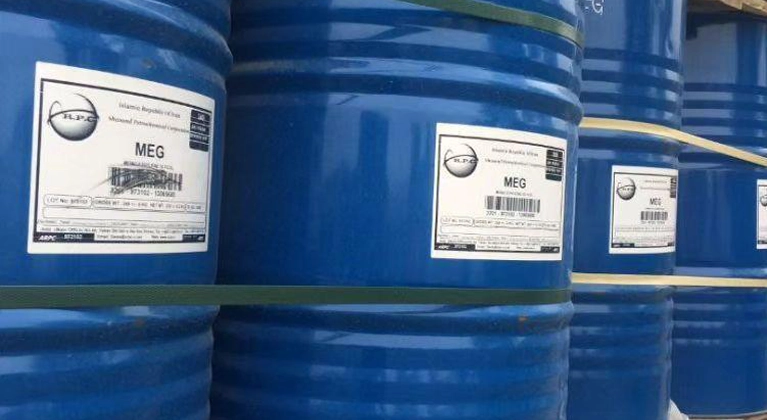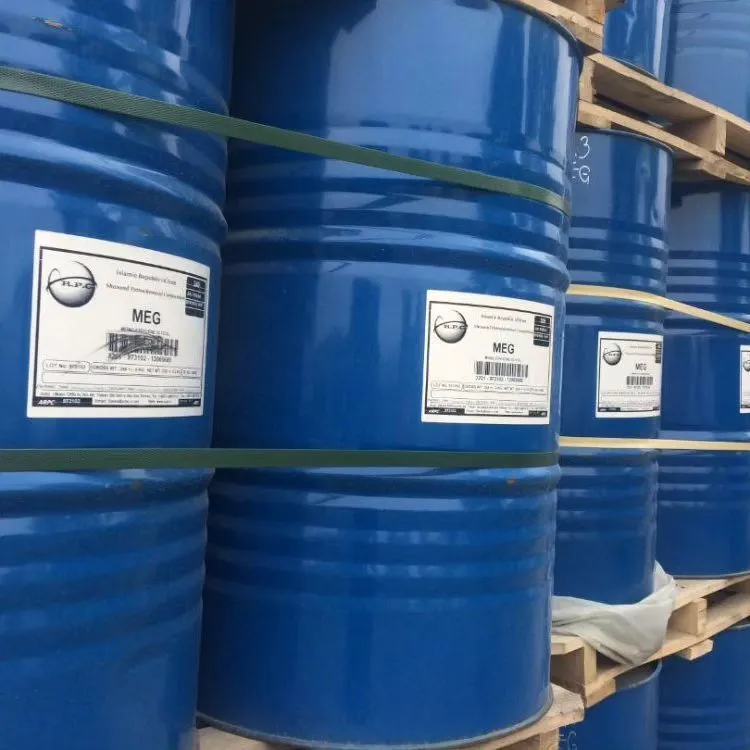Supplier of High-Quality Mono Ethylene Glycol-MEG

Mono Ethylene Glycol Product Description
Mono ethylene glycol, commonly known as MEG or ethylene glycol, is a foundational organic compound in the chemical sector—think of it as the reliable multitasker that keeps industries running smoothly. With the chemical formula C₂H₆O₂ and CAS number 107-21-1, this diol appears as a clear, colorless, slightly viscous liquid with a subtly sweet taste and virtually no odor. It’s fully miscible with water, alcohols, and a range of organic solvents, making it a seamless fit for diverse formulations. Produced industrially from ethylene through ethylene oxide hydration—via thermal or catalytic processes—MEG belongs to the glycol family of alcohols, prized for its antifreeze capabilities and solvent prowess. For international buyers seeking consistency, sourcing high-purity mono ethylene glycol ensures minimal impurities, supporting everything from high-volume polyester runs to precision coolant blends without the headaches of variability.
Physical and Chemical Properties of Mono Ethylene Glycol
Diving into what makes mono ethylene glycol tick, its properties blend practicality with performance—easy to grasp specs that translate to real efficiencies in your operations. Here’s a focused look at MEG’s standout traits, verified against global standards:
- Appearance: Clear, colorless liquid with a syrupy viscosity—straightforward for visual quality checks.
- Odor: Virtually odorless, keeping workspaces clean and focused.
- Density (at 20°C): 1.113 g/cm³, enabling precise measurements for accurate batching.
- Boiling Point: 197.3°C, robust for heat-transfer roles without rapid vapor loss.
- Freezing Point: -12.9°C, the ideal starting point for freeze-protection solutions.
- Viscosity (at 20°C): Slightly viscous at around 16.1 mPa·s, balancing flow and stability.
- Solubility: Highly miscible in water, ethanol, and organic solvents—unlocking endless blending potential.
- pH (100% solution): 6.5-7.5, neutral for wide compatibility in mixes.
- Flash Point: 111°C (closed cup), low flammability for safer handling.
- Chemical Stability: Stable under ambient conditions, with hygroscopic tendencies that aid moisture control.
These mono ethylene glycol characteristics aren’t mere footnotes; they’re the building blocks for dependable results, from extending equipment life to refining product quality in competitive markets.
Applications and Uses of Mono Ethylene Glycol
What elevates monoethylene glycol from a basic chemical to an industry staple? It’s MEG’s knack for solving everyday challenges across sectors, adapting its thermal and solvency strengths to boost efficiency and innovation. Imagine streamlining your supply chain with one compound that handles antifreeze in the dead of winter and resin synthesis under high heat— that’s the edge commercial buyers chase. Below, we break down key mono ethylene glycol applications, with practical insights to spark ideas for your workflows:
- Antifreeze and Coolants: In automotive engines and HVAC setups, ethylene glycol prevents coolant freezing in subzero temps while raising boil points to combat overheating—essential for fleet managers and facility operators aiming for year-round reliability.
- Polyester Production: Reacts with terephthalic acid to form PET resins and fibers; vital for textile mills crafting apparel, and for packagers producing billions of recyclable bottles annually.
- Dehydration of Natural Gas: Acts as a water scavenger in gas processing, inhibiting hydrate plugs in pipelines— a game-changer for energy firms in cold offshore environments.
- Chemical Intermediary: Builds resins, solvents, and plasticizers for downstream uses in paints, adhesives, and inks, fueling seamless integration in manufacturing chains.
- Heat Transfer Fluids: Circulates in refrigeration, solar thermal systems, and industrial chillers, leveraging its wide temperature range for precise energy management.
- Hydraulic and Brake Fluids: Enhance fluid performance in vehicles and machinery, maintaining viscosity across temperature swings for safer, smoother operations.
- Solvent in Paints and Coatings: Improves flow and adhesion in formulations, delivering durable finishes for construction and automotive coatings.
- Humectant in Cosmetics and Tobacco: Retains moisture in lotions, conditioners, and cigarette blends, extending shelf life and sensory appeal.
- De-icing Fluids: Clears frost from aircraft wings and runways swiftly, prioritizing aviation safety with low-residue evaporation.
For fortified heat-transfer systems, consider blending monoethylene glycol with diethylene glycol to amp up corrosion resistance. As a trusted mono ethylene glycol supplier, we guide buyers toward applications that align with your goals, turning potential into scalable success.
Handling, Storage, and Transportation of Mono Ethylene Glycol
Mono ethylene glycol demands respect—it’s effective, but mishandling can turn efficient into effortful. We’ve all faced tight deadlines where safety shortcuts tempt; instead, lean on these proven practices to keep your team protected and MEG pristine, drawing from real-world logistics that prioritize compliance and ease.
- Handling Precautions: Don nitrile gloves, goggles, and ensure ventilation; while low in acute toxicity, avoid ingestion or skin absorption—flush exposures with water and seek medical advice if needed to prevent issues like irritation or systemic effects.
- Storage Recommendations: Seal in cool (15-25°C), dry, well-ventilated spots away from oxidizers, acids, or ignition sources—tight lids curb its hygroscopic pull, preserving purity for months.
- Transportation Protocols: Non-hazardous per most regs (UN 3082 for eco-sensitive loads), but use dry, dedicated tanks with spill containment; brace for transit vibrations, loading up to 24 tons per 20-foot container under IMO guidelines for global routes.
These steps aren’t red tape—they’re smart safeguards that minimize risks and maximize on-time deliveries, whether shipping to Asian refineries or European textile hubs.
Packing Details and Container Loading for Mono Ethylene Glycol
Packaging mono ethylene glycol smartly means matching form to function—adaptable options that safeguard quality while fitting your scale, from lab trials to mega-productions. We prioritize durable, compliant formats that cut waste and ease customs, with exact loading figures for hassle-free planning.
- Small Quantities: Corrosion-resistant 220 kg steel or HDPE drums (up to 80 per 20-foot container, ~17.6 tons total)—ideal for spot buys or R&D, stacking neatly for regional hauls.
- Medium Quantities: 1,000 L IBCs with steel-caged plastic bodies (20 units, ~20 tons per 20-foot)—reusable and robust for mid-tier distributors, balancing cost with security.
- Bulk Quantities: Carbon or stainless steel ISO tanks (22-24 tons per 20-foot, 44-48 tons per 40-foot), often heated for flow—suited for high-volume importers, minimizing per-ton freight.

TECHNICAL DATA SHEET OF Mono Ethylene Glycol (MEG)
| Appearance | Colourless, transparent |
|---|---|
| Purity | 99.8 wt % min |
| Colour (Pt-Co) | 5 max |
| DEG | 0.08 wt % max |
| Water | 0.08 wt % max |
| Specific gravity, 20/20 C | 1.1151-1.1156 |
| Boiling range at 0.1013 Mpa | – |
| 5% vol | Min. 196 C |
| 95% vol | Max. 199 C |
| Aldehydes (as formaldehyde ) | 8 mg/kg max |
| Acidity (as acetic acid) | 10 mg/kg max |
| Iron (as Fe) | 0.1 mg/kg max |
| Inorganic chlorides (as Cl) | 0.05 mg/kg max |
| Ash | 50 mg/kg max By Req=10 mg/kg max |
| UV Transmittance | – |
| -220nm | 80 min |
| -275nm | 95 min |
| -350 m | 99 min |


